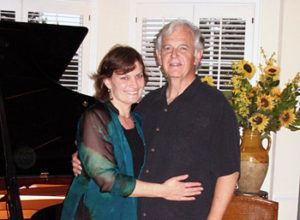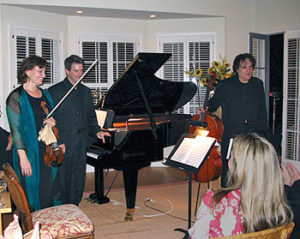Broughtons’ Bel-Air House Concert
Third in chamber music series hosted by esteemed composer and violinist spouse-team

Violinist Belinda Broughton and composer Bruce Broughton
LOS ANGELES—The three Bs of music used to be Bach, Beethoven and Brahms. But on Saturday, Oct. 18, a chamber-music evening featured three more modern Bs – Britten, Bernstein and Broughton – with performances that were decidedly A level.
There’s nothing like live chamber music in an intimate setting, with food and wine and friends. Bruce and Belinda Broughton hosted the third in their series of “Bel-Air House Concerts” that mixed a wonderful informality with some first-rate music-making.
After Belinda’s extraordinary all-vegetarian buffet-style dinner – which everyone consumed in different spots of the Broughtons’ comfortable house, built in 1939 and once owned by actress Maureen O’Sullivan – cellist Andrew Shulman and pianist Robert Thies performed Benjamin Britten’s “Sonata for Cello and Piano,” op. 65, written in 1960.
The evening’s informality was confirmed when Shulman offered amusing introductory anecdotes about legendary cellist Mstislav Rostropovich, who was performing in London many years ago, inviting fellow musicians over for late-night drinks and story-telling.

Belinda Broughton, violin; Robert Thies, piano; and Andrew Shulman, cello
Shulman, together with pianist Robert Thies, performed the Britten work. It was a marvel, with the intense, dialogue-like first movement giving way to a more delicate and colorful second movement. Britten’s memorable third movement, a dramatic and emotional elegy, shifted into an energetic fourth featuring fascinating effects, and an obviously difficult, fast-paced finale.
The Broughtons – Bruce on piano, Belinda on violin – shared center stage with a recent Pacific Serenades commission, Broughton’s “Sonata for Violin and Piano.” About 17 minutes in length, it features an exciting opening with some very rhythmic moments, very 20th-century in approach. The second movement, by contrast, was evocative and contemplative, more Americana in idiom; the third movement was challenging, with big dramatic gestures and delightful pizzicato effects.
Shulman, Thies and Belinda Broughton concluded with Leonard Bernstein’s 1937 “Trio for Violin, Cello and Piano.” Bruce Broughton introduced it as an “entertaining piece” in which “you can hear a bit of the Bernstein to be… he’s not quite there yet.” The composer was 19 when he wrote it.
The opening was bright and lively, the second movement light and amusing. Listeners were reminded of the informality of the evening when the Broughton’s dog Josie silently sauntered through the music room in the middle of the fast, fun finale. As an encore, the trio played Gabriel Faure’s brief but rapturous “After a Dream.”
As always with the Broughtons, the crowd was as interesting as the music – educators, musicians, friends, even a few fellow composers (John Powell, Patrick Doyle, Richard Bellis, Arni Egilsson). Fine wine, great food, superb music and memorable company – given the state of the nation and the economy, one might say we need all this more than ever.
